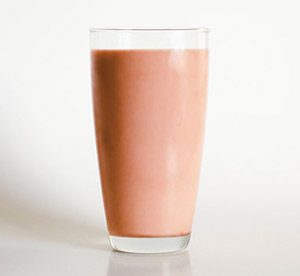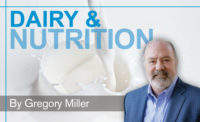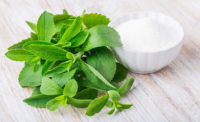
|
|
Milk contains natural sugars. The added sugars in flavored milk have led school boards and parents to ban the beverage or request lower-sugar alternatives. Milk processors are developing new formulations.
Photo courtesy of Steviva Brands |
Dairy manufacturers are well aware of the health-and-wellness trend that is forcing serious re-evaluations of their ingredient choices.
As Thomas King, president of a Portland, Ore.-based sweetener supplier, said, “Four of the top five food trends for 2013 pertain to health, GMOs and clean labels. This is a huge selling factor, particularly in the dairy category because of the target demographic of children and the mothers purchasing for them.”
But even more than general health, he noted, “People are scrutinizing the calorie content of dairy favorites like chocolate milk.”
And that doesn’t bode well for sugar. Sure, fat contributes its share of energy to dairy items — and school districts, public health advocates and others have encouraged a shift toward reduced-fat dairy options as a result. But with reduced-fat versions of milk, yogurt, ice cream and frozen novelties now commonplace, it may be time to place sugar in the spotlight.
Packing a wallop
There’s no way around it. Some sweetened dairy classics pack a wallop of sugar calories. A mere half-cup serving — and who stops at just that? — of a national-brand vanilla ice cream might contain as much as 20 grams of sugar, accounting for about 30% of its roughly 250 kcal.
But — one might argue — ice cream is dessert and can be excused its excess. “Healthier” dairy foods like yogurt will surely have a more virtuous sugar content, right? Not necessarily.
“Fruit-prepped yogurt has more calories than a sugary soft drink,” King said.
A 6-ounce container of a typical strawberry variety will add 27 grams of sugar to a consumer’s daily tally, contributing almost two thirds of the product’s 170 kcal. For comparison, a 6-ounce serving of cola gets all of its 70-odd kcal from just over 19 grams of sugars — a lot of sugar, to be sure, but still less than that yogurt.
And as for chocolate milk, the unlikely subject of so much recent school-lunch controversy, whether it’s sweetened with cane sugar, corn syrup, agave nectar or other nutritive sweetener, “You end up, oftentimes, with 25 grams, 29 grams or even 30 grams of sugar” per 8-ounce serving, said Paul Kim, technical manager for the Americas division of an international sweetener supplier. “And that’s quite a bit.”
Bulking up
As Carol Rainford, a dairy scientist at a multinational sweetener supplier, said, “As the healthy, better-for-you trend continues the demand for flavorful reduced-sugar and –calorie products also increases.”
Sugar plays an important role in dairy products. Its functional benefits include body and mouthfeel in fluid dairy; crystal formation and freeze point depression; and flavor perception, said Adams M. Berzins, a food scientist and principal technologist in the Newark, Del., office of a Chicago-based sweetener supplier.
But satisfying that demand will mean more than merely subbing out the sugar in existing dairy formulations with a low-calorie, high-intensity alternative sweetener. And that’s because in dairy products, sugars do a lot more than just taste sweet.
Consider the matter of bulk. In the aforementioned chocolate milk, those 29 grams of sugar make up a little over an eighth of the 8-ounce serving’s volume, but when you replace them with an alternative sweetener whose taste intensity may be hundreds, possibly thousands, of times sweeter than sugar’s, you’re going to use a lot less of it. So what do you do with all that leftover space? You fill it with bulking agents.
Said Rainford, “Sugar reduction for fluid dairy products is usually easily attained by slightly increasing the level of starch or hydrocolloids in the formula. This is also the case for reduced-sugar fruit preparations that are added to yogurts.”
Go-to bulking options include polydextrose, maltodexrin and various polyols. Similarly, carrageenan and sulfated polysaccharides, as well as xanthan, guar and other gums can offset the space opened up when removing sugar’s bulk. While not calorie-free, many bulking agents contribute fewer than sugar’s 4 kcal/gram, so they still help lower the calorie total relative to full-sugar formulations.
Bulking agents can also bring texture to reduced-sugar dairy products — helping restore the body and mouthfeel that sugar had lent — and they can act as stabilizers, too. Optimization of the stabilizer is especially important for frozen products, often requiring a sort of custom tailoring for each formulation to account for “variances in processing parameters, equipment, fat content and overrun,” Rainford said.
Sugar’s role in ice cream
But Rainford’s vote for “the biggest dairy sugar-reduction challenge” in the freezer case is ensuring sufficient freezing-point depression. In traditional ice cream, the presence of sugar interferes with water molecules’ ability to harden into a firm, icy matrix at water’s usual freezing point. This interference is why ice cream is soft enough to scoop straight from the freezer, while you can’t swipe a spoon through a block of pure ice.
But when you remove sugar from an ice cream mix, those water molecules are free to freeze more firmly and rapidly, and at a higher temperature than if its solids were present. And because high-intensity sweeteners don’t provide the same quantity of solids as sugar did, “rebalancing the lost solids is crucial to achieving the desired freezing point and texture of the product,” Rainford said.
Again, bulking and texturizing agents save the day. A combination of polyols and higher molecular-weight polymers can tilt the freezing point downward; so, too, can soluble corn fiber, notes Rainford’s colleague, Tammy Reinhart, business and development manager at the company’s food systems division.
And while replacing sucrose with honey won’t lower ice cream’s calories — both deliver 4 kcal/gram — Catherine Barry, director of marketing for honey’s trade group, points out that honey will lower its freezing point — and keep the label looking clean besides. Honey may prove more functional in depressing ice cream’s freezing temperature than sugar, dropping it from 28.2 F at 14% sucrose to 26.4 F with a comparable quantity of honey — a decrease of about 6%.
Credit for the depression goes to honey’s fructose and water contents of 38.5% and 17.1%, respectively. Research shows that adding fructose to ice cream increases the melting rate compared to glucose syrup, Barry said, and, “in addition, ice creams with high water content experience longer hardening times because more heat of fusion has to be eliminated.”
Honey also acts as a prebiotic in yogurt and cultured dairy beverages, Barry said, “enhancing the growth, activity and viability of commercial strains of bifidobacteria typically used in the manufacture of fermented dairy products.”
The effect is similar to that of oligosaccharides like inulin, which also show up in yogurt products as prebiotics, she said.
Alas, high-intensity sweeteners won’t yield the same fermentative benefits as honey and other caloric sugars; just as they’re not nutritive to us, they’re not nutritive to bacteria, either. And, Reinhart said, different sweetener systems ultimately affect “the acid flavor development, body and texture” of yogurts where they appear” differently.
She suggests that manufacturers reducing sugar solids in yogurt opt for a “tailored system of starch and/or hydrocolloids” to maintain body and texture.
The alteration of flavor that’s nearly inevitable with high-intensity sweeteners is a high hurdle for dairy manufacturers to clear, and a tough change for consumers to accept. After all, as the traditional dairy sweetener, old-fashioned sugar has left a strong impression on their palates. High-intensity alternatives just aren’t the same thing.
“Sucrose tends to have a relatively early onset of sweetness, and then it has a very rounded sweetness,” Kim explained. “It dissipates relatively cleanly. And it has no aftertaste. People are used to that and they expect it.”
By contrast, high-intensity sweeteners follow a different time-intensity profile and can contribute bitter, metallic “off” tastes in addition to a lingering sweetness.
Improving the alternatives
By blending the latest in high-intensity technology with taste-modification ingredients, texturizers and masking flavors, we’re getting better at bringing reduced-sugar formulations nearer to their full-sugar ideals.
Experts agree that working with sweetener blends is the first step toward improving the appeal of high-intensity-sweetened dairy. Blends have the ability of the different high-intensity sweeteners to compensate for each other’s flaws. So, for example, the delayed onset and lingering sweetness of sucralose and aspartame recede when balanced with the very early-onset sweetness and clean, quick dissipation of acesulfame potassium.
But dairy manufacturers searching for the perfect high-intensity blend might do well to remember that their reformulations needn’t be an all-or-nothing proposition. In other words, reducing the sugar in dairy may serve everyone’s purposes — from health advocates and manufacturers to consumers — better than removing it outright.
“Since there already are sugars, carbohydrates and calories in dairy products naturally, manufacturers should shoot for ‘reduced sugar’ and ‘low glycemic,’ and manufacture for taste with an eye on calories,” King said.
Fortunately, our brains don’t vigorously dissect all these different sweeteners, flavors, mouthfeel enhancers and texturizers in every dairy treat we enjoy. Somehow, someway, our sensory “nerve centers” integrate it all into a holistic experience that becomes what we remember. As Kim points out — in words that should flash in neon above every dairy developer’s benchtop — “At the end of the day, consumers look at the whole picture: either it’s good or it’s not.”
Executives from these suppliers are quoted in this article.
• Celanese/Nutrinova, Somerset N.J.
• Ingredion, Chicago
• National Honey Board, Firestone, Colo.
• Steviva Brands, Portland, Ore.
• Tate & Lyle Food Systems, Decatur, Ill.
• The MSR Group, Omaha, Neb.
Find more suppliers of sweeteners in the Dairy Foods Buyers Guide, buyersguide.dairyfoods.com/buyersguide







